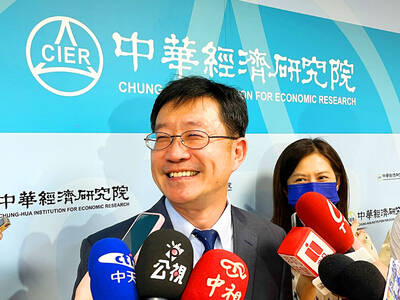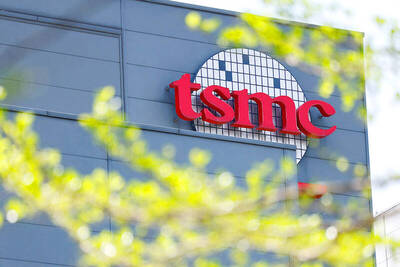Memorychip testing and packaging services provider Powertech Technology Inc (力成科技) expects revenue this year to grow at an annual single-digit percentage rate, driven primarily by robust demand for artificial intelligence (AI) devices and data centers this quarter.
The company is investing heavily in advanced packaging technologies including panel-level packaging and chip-on-wafer-on-substrate (CoWoS) technologies to further capture AI opportunities, and is in talks with customers to provide CoWoS solutions, CEO Boris Hsieh (謝永達) told an investors’ conference yesterday.
The company aims to provide a complete CoWoS solution rather than only providing the easier part of the back-end solution, he said.

Photo: Grace Hung, Taipei Times
AI applications accounted for 8 percent of the company’s revenue last quarter, rising from 6 percent in the second quarter and 4 percent in the first quarter.
This year’s growth momentum would also be fueled by the spillover effect of a high bandwidth memory (HBM) expansion, Hsieh said.
That means Powertech has a chance to receive more orders to provide standard DRAM chip testing and packaging services from the world’s three major memorychip makers, which have allocated significant capacity to produce HBM DRAM chips to support surging AI demand.
Revenue last year plummeted about 16 percent to NT$70.44 billion (US$2.19 billion) amid the global semiconductor industry’s worst slump in more than 20 years, it said.
“The total consolidated revenue can still grow by a single-digit percentage year-on-year this year in the absence of revenue from China’s Xian plant,” Hsieh said.
Powertech previously produced standard DRAM chips for Micron Technology Inc at the Xian plant based on a supply agreement, which expired in June.
As a result, Powertech’s revenue dropped 6.6 percent quarterly, and down 0.8 percent annually, to NT$18.3 billion last quarter.
Net profit fell 7 percent to NT$2.15 billion last quarter, from NT$2.31 billion the previous quarter, as the company posted nonoperating losses of NT$63 million in the quarter, mainly due to significant foreign exchange losses, it said.
On an annual basis, net profit rose 8 percent from NT$1.99 billion.
Gross margin improved to 21.4 percent last quarter from 19 percent in the previous quarter and 17.8 percent in the same period last year, the company said.
In the first three quarters, total net profit soared 27.5 percent annually to NT$6.57 billion, from NT$5.16 billion, while earnings per share rose to NT$7.05 from NT$5.41 and revenue increased 9.4 percent to NT$56.22 billion from NT$51.41 billion, it said.

WEAKER ACTIVITY: The sharpest deterioration was seen in the electronics and optical components sector, with the production index falling 13.2 points to 44.5 Taiwan’s manufacturing sector last month contracted for a second consecutive month, with the purchasing managers’ index (PMI) slipping to 48, reflecting ongoing caution over trade uncertainties, the Chung-Hua Institution for Economic Research (CIER, 中華經濟研究院) said yesterday. The decline reflects growing caution among companies amid uncertainty surrounding US tariffs, semiconductor duties and automotive import levies, and it is also likely linked to fading front-loading activity, CIER president Lien Hsien-ming (連賢明) said. “Some clients have started shifting orders to Southeast Asian countries where tariff regimes are already clear,” Lien told a news conference. Firms across the supply chain are also lowering stock levels to mitigate

Six Taiwanese companies, including contract chipmaker Taiwan Semiconductor Manufacturing Co (TSMC, 台積電), made the 2025 Fortune Global 500 list of the world’s largest firms by revenue. In a report published by New York-based Fortune magazine on Tuesday, Hon Hai Precision Industry Co (鴻海精密), also known as Foxconn Technology Group (富士康科技集團), ranked highest among Taiwanese firms, placing 28th with revenue of US$213.69 billion. Up 60 spots from last year, TSMC rose to No. 126 with US$90.16 billion in revenue, followed by Quanta Computer Inc (廣達) at 348th, Pegatron Corp (和碩) at 461st, CPC Corp, Taiwan (台灣中油) at 494th and Wistron Corp (緯創) at

NEGOTIATIONS: Semiconductors play an outsized role in Taiwan’s industrial and economic development and are a major driver of the Taiwan-US trade imbalance With US President Donald Trump threatening to impose tariffs on semiconductors, Taiwan is expected to face a significant challenge, as information and communications technology (ICT) products account for more than 70 percent of its exports to the US, Chung-Hua Institution for Economic Research (CIER, 中華經濟研究院) president Lien Hsien-ming (連賢明) said on Friday. Compared with other countries, semiconductors play a disproportionately large role in Taiwan’s industrial and economic development, Lien said. As the sixth-largest contributor to the US trade deficit, Taiwan recorded a US$73.9 billion trade surplus with the US last year — up from US$47.8 billion in 2023 — driven by strong

ASE Technology Holding Co (ASE, 日月光投控), the world’s biggest chip assembly and testing service provider, yesterday said it would boost equipment capital expenditure by up to 16 percent for this year to cope with strong customer demand for artificial intelligence (AI) applications. Aside from AI, a growing demand for semiconductors used in the automotive and industrial sectors is to drive ASE’s capacity next year, the Kaohsiung-based company said. “We do see the disparity between AI and other general sectors, and that pretty much aligns the scenario in the first half of this year,” ASE chief operating officer Tien Wu (吳田玉) told an